Internet Identity認証の利用
はじめに
分散型クラウド環境『Internet Computer』が提供する『Internet Identity(II)』と呼ばれるユーザー認証システムを、Frontendアプリケーションから利用する方法について解説します。
Internet Identityとは…
Internet Identitityは、Internet Computer上で動作する各Dappsにユーザー認証機能を提供します。WebAuthnに対応しており、パスワードを使わずにノートパソコンやスマートフォンでの生体認証やYubiKeyなどのデバイスを利用したユーザー認証ができます。
ユーザーごとに『Identity Anchor』と呼ばれる一意の数値が割り当てられ、各Dappからは『Principal』という識別子で取り扱われます。同一ユーザーでもDappごとにPrincipalが変わるため、Dappをまたいでユーザーをトラッキングしにくいという特徴があります。
サンプルの概要
以下のCanisterを開発します。
| Canister | 概要 |
|---|---|
| Backend | 呼び出し元のPrincipalを返します。 |
| Frontend | Internet Identityを使ってユーザー認証を行い、Backendを呼び出します。 |
開発
1. プロジェクトの作成
dfx newコマンドで、ひな型プロジェクトを用意します。
(1) Backend language
本記事では、Backend開発にRustを使用します。
$ dfx new iitest
? Select a backend language: ›
Motoko
❯ Rust
TypeScript (Azle)
Python (Kybra)
(2) Frontend framework
本記事では、なるべくシンプルな解説とするためVanilla JSを選択します。
? Select a frontend framework: ›
SvelteKit
React
Vue
❯ Vanilla JS
No JS template
No frontend canister
(3) Extra features
Internet Identityをチェックします。
? Add extra features (space to select, enter to confirm) ›
✔ Internet Identity
⬚ Bitcoin (Regtest)
⬚ Frontend tests
2. ディレクトリ構造
dfx newコマンドの実行が終わると、以下のディレクトリとファイルが作成されます。
iitest
├── .git
│ ︙
├── .gitignore
├── Cargo.lock
├── Cargo.toml
├── README.md
├── dfx.json
├── node_modules
│ ︙
├── package-lock.json
├── package.json
├── src
│ ├── iitest_backend
│ │ ├── Cargo.toml
│ │ ├── iitest_backend.did
│ │ └── src
│ │ └── lib.rs
│ └── iitest_frontend
│ ├── assets
│ │ ├── .ic-assets.json5
│ │ └── favicon.ico
│ ├── index.html
│ ├── package.json
│ ├── src
│ │ ├── App.js
│ │ ├── index.scss
│ │ ├── logo2.svg
│ │ ├── main.js
│ │ └── vite-env.d.ts
│ ├── tsconfig.json
│ └── vite.config.js
└── tsconfig.json
開発のために、プロジェクトディレクトリに移動しましょう。
$ cd iitest
3. Backendの修正
呼び出し元のPrincipalを返すだけのqueryメソッドを用意します。
(1) src/iitest_backend/iitest_backend.did
Canisterが提供するqueryメソッドを定義します。
service : {
"whoami": () -> (text) query;
}
(2) src/iitest_backend/src/lib.rs
ic_cdk::caller()で呼び出し元のPrincipalが取得できますので文字列に変換して返します。
#[ic_cdk::query]
fn whoami() -> String {
ic_cdk::caller().to_string()
}
4. Frontendの修正
FrontendでInternet Identityを利用するには、@dfinity/auth-clientパッケージのインストールが必要です。
npmコマンドなどでインストールします。
$ npm install -w src/iitest_frontend --save @dfinity/auth-client
パッケージを最新化する場合
dfx newコマンドで出力された内容が古い場合、パッケージの依存関係の問題で@dfinity/auth-clientパッケージのインストールに失敗する場合があります。
そのような場合には、ncu (npm-check-updates)などを使って各パッケージを最新化しておくとよいでしょう。
$ ncu -ws -u
Upgrading /home/toshio/workspace/hello/iitest/src/iitest_frontend/package.json
[====================] 12/12 100%
@dfinity/agent ^0.20.0 → ^1.3.0
@dfinity/candid ^0.20.0 → ^1.3.0
@dfinity/principal ^0.20.0 → ^1.3.0
@testing-library/jest-dom ^5.16.5 → ^6.4.6
cross-fetch ^3.1.6 → ^4.0.0
dotenv ^16.3.1 → ^16.4.5
lit-html ^2.8.0 → ^3.1.4
sass ^1.63.6 → ^1.77.5
typescript ^5.1.3 → ^5.4.5
vite ^4.3.9 → ^5.3.0
vitest ^0.32.2 → ^1.6.0
Run npm install to install new versions.
$ npm install
src/iitest_frontend/src/App.js
テンプレート出力されたFrontendソースファイルのうち、メインページの部分を以下に差し替えます。
あくまでも一例にすぎませんので、本格的に開発する際には使用するFrontend frameworkに適した形で実装してください。
import { html, render } from 'lit-html';
import { Actor } from "@dfinity/agent";
import { AuthClient } from "@dfinity/auth-client";
import { iitest_backend } from 'declarations/iitest_backend';
class App {
message = '';
authClient = null;
constructor() {
this.checkAuth();
}
async checkAuth() {
try {
this.authClient = await AuthClient.create();
} finally {
this.render();
}
}
async render() {
const principal = this.authClient?.getIdentity().getPrincipal();
const isAuthenticated = await this.authClient?.isAuthenticated();
let body = html`
<main>
<h2>Welcome, ${principal}</h2>
<button id="buttonLogin" ?disabled=${isAuthenticated}>Login</button>
<button id="buttonLogout" ?disabled=${!isAuthenticated}>Logout</button>
<br/>
<button id="buttonWhoami">whoami</button>
<section>${this.message}</section>
</main>
`;
render(body, document.getElementById('root'));
document.getElementById('buttonLogin').onclick = ()=>this.buttonLogin();
document.getElementById('buttonLogout').onclick = ()=>this.buttonLogout();
document.getElementById('buttonWhoami').onclick = ()=>this.buttonWhoami();
}
async buttonLogin() {
try {
await new Promise((resolve, reject)=>{
this.authClient?.login({
identityProvider: process.env.DFX_NETWORK === 'ic' ?
'https://identity.ic0.app/#authorize' :
`http://${process.env.CANISTER_ID_INTERNET_IDENTITY}.localhost:4943/#authorize`,
maxTimeToLive: BigInt(7 * 24 * 60 * 60 * 1000 * 1000 * 1000),
onSuccess: resolve,
onError: reject
});
});
} catch (e) {
alert(e);
} finally {
this.render();
}
}
async buttonLogout() {
await this.authClient?.logout();
this.render();
}
async buttonWhoami() {
if (this.authClient) {
// Change identity
const agent = Actor.agentOf(iitest_backend);
agent.replaceIdentity(this.authClient.getIdentity());
// Invoke backend
const whoami = await iitest_backend.whoami();
this.message = `${whoami}`;
this.render();
}
}
}
export default App;
プログラム解説
AuthClient.create()で生成したAuthClientインスタンスのlogin()関数、logout()関数、isAuthenticated()関数、getIdentity()関数などを用いてユーザー認証制御を行います。
dfx deployコマンド実行時にdeclarationsディレクトリ配下に出力されるBackend Canisterの呼び出し処理iitest_backend.whoami()は通常匿名ユーザーで実行されますが、以下のようにauthClient.getIdentity()関数で取得したIdentityを割り当てることによって、認証したユーザーでBackend canisterを呼び出すことができます。
const agent = Actor.agentOf(iitest_backend);
agent.replaceIdentity(this.authClient.getIdentity());
5. Local Canister実行環境の起動
dfx startコマンドでLocal Canister実行環境を起動します。
$ dfx start --background --clean
6. Deploy
dfx deployコマンドでLocal Canister実行環境にCanisterをDeployします。
$ dfx deploy
Deploying all canisters.
Creating canisters...
︙
Deployed canisters.
URLs:
Frontend canister via browser
iitest_frontend:
- http://127.0.0.1:4943/?canisterId=bd3sg-teaaa-aaaaa-qaaba-cai
- http://bd3sg-teaaa-aaaaa-qaaba-cai.localhost:4943/
internet_identity:
- http://127.0.0.1:4943/?canisterId=be2us-64aaa-aaaaa-qaabq-cai
- http://be2us-64aaa-aaaaa-qaabq-cai.localhost:4943/
Backend canister via Candid interface:
iitest_backend: http://127.0.0.1:4943/?canisterId=br5f7-7uaaa-aaaaa-qaaca-cai&id=bkyz2-fmaaa-aaaaa-qaaaq-cai
internet_identity: http://127.0.0.1:4943/?canisterId=br5f7-7uaaa-aaaaa-qaaca-cai&id=be2us-64aaa-aaaaa-qaabq-cai
7. 実行
dfx deployコマンド実行時に表示される、iitest_frontendのURLをブラウザから開きます。
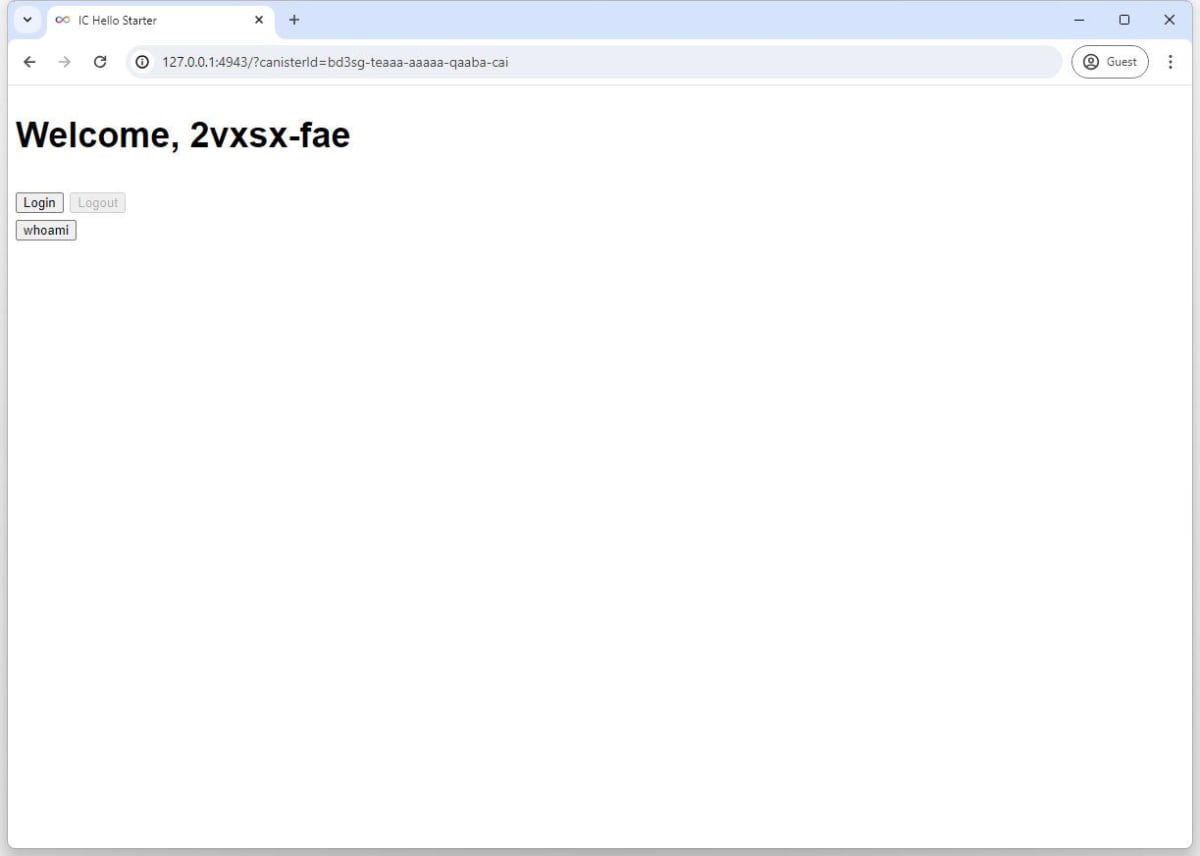
(1) ログイン前のBackend呼び出し
[whoami]ボタンをクリックすると、Backendから匿名のPrincipalを示す『2vxsx-fae』が返ってきます。
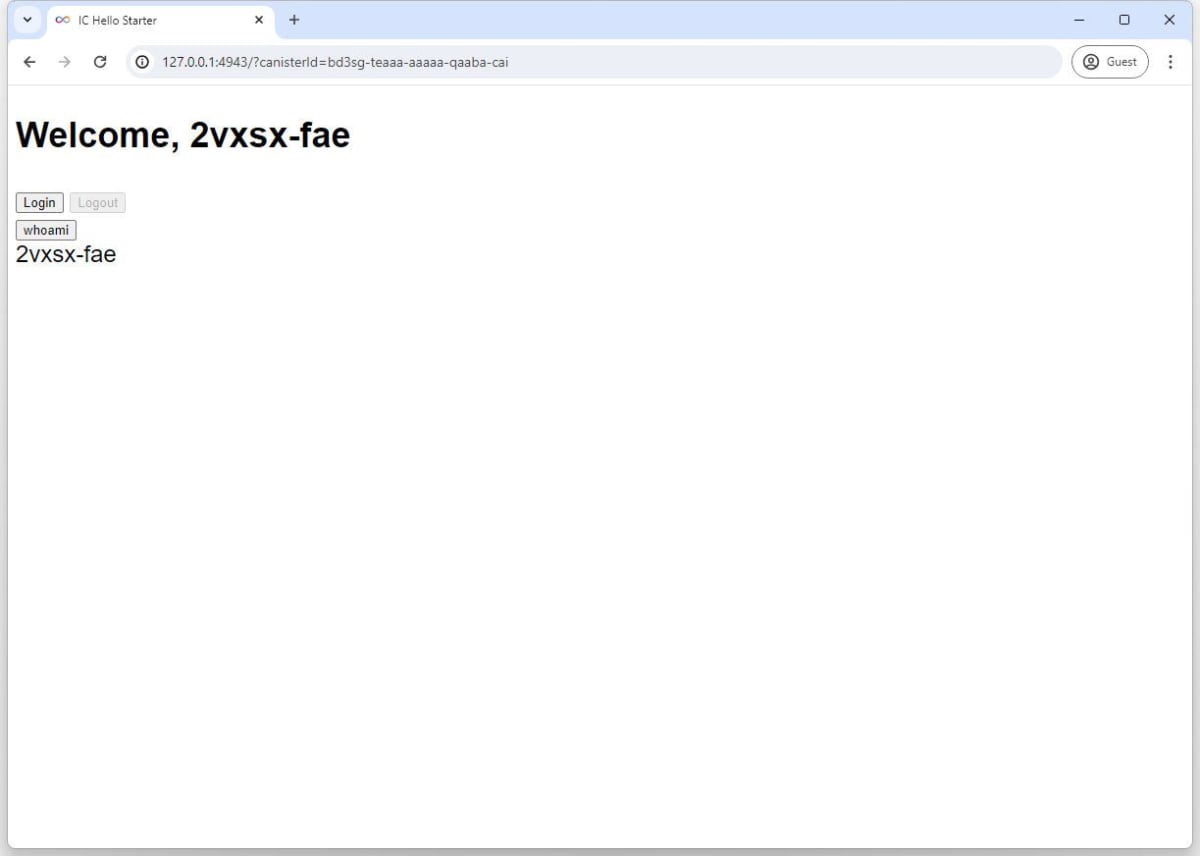
(2) Internet Identityユーザー作成
[login]ボタンをクリックすると、新しいタブにLocal Canister実行環境にDeployしたテスト用のInternet Identity認証画面が表示されます。
初回起動時はまだ何のユーザーも登録されていませんので、
[Create Internet Identity]ボタンをクリックして、新しいユーザーを作成します。
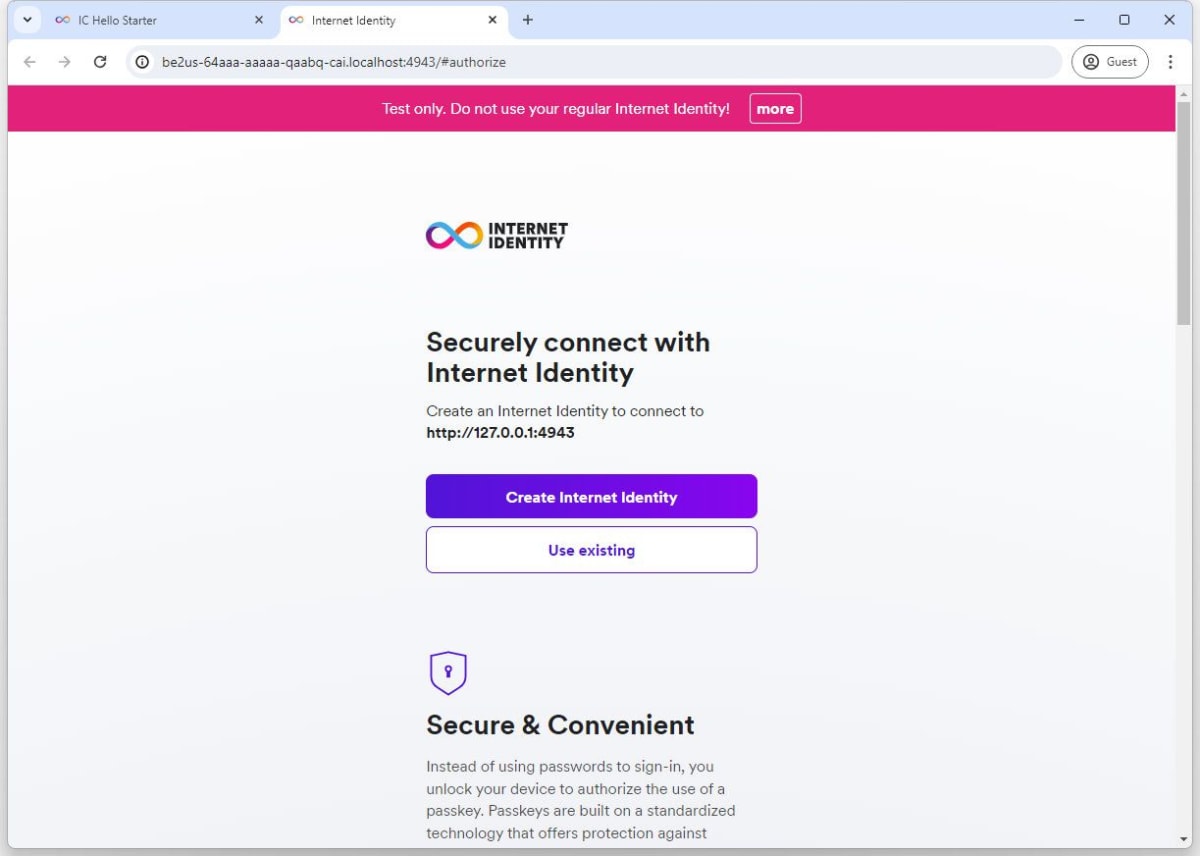
(3) Passkey作成
[Create Passkey]ボタンをクリックします。
テスト用のInternet Identityですのでデバイス登録は不要です。
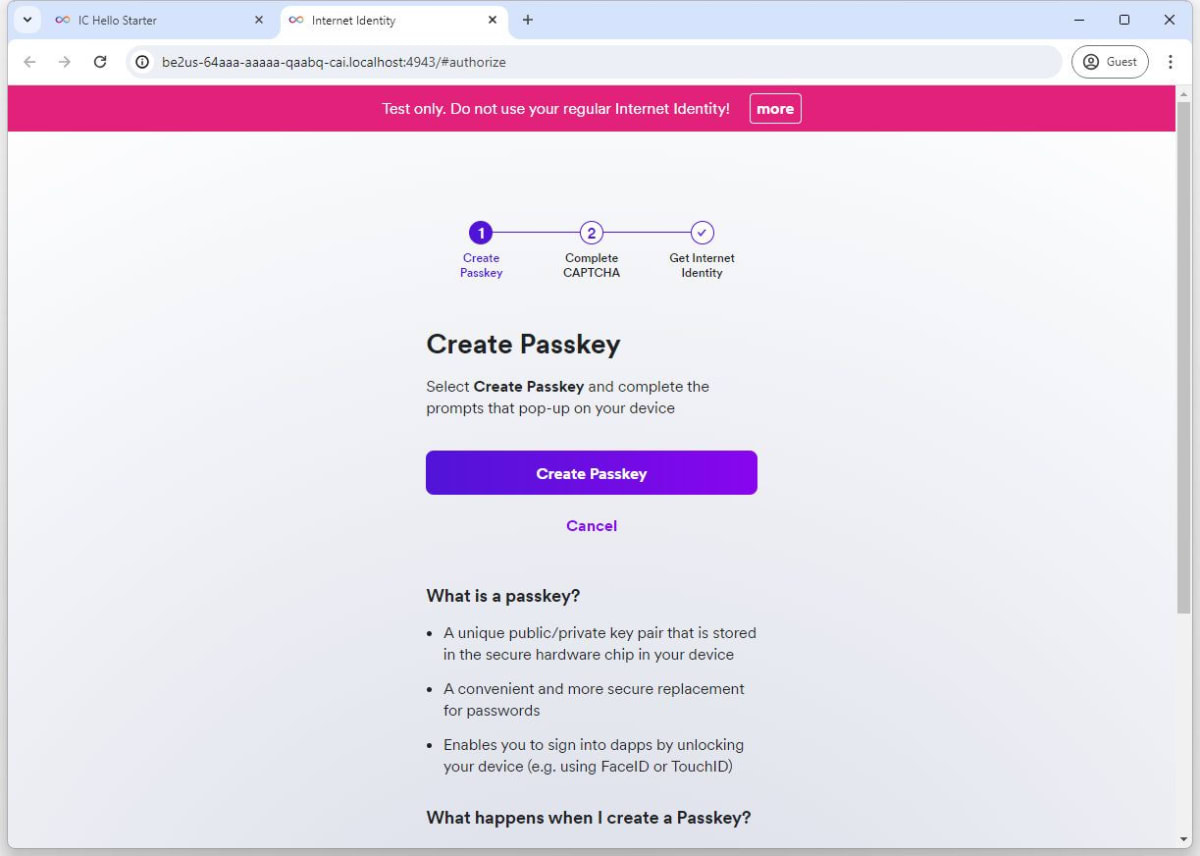
(4) CAPTCHA画面
Botでないことの確認をします。
テスト用ですので、aと入力して[Next]をクリックします。
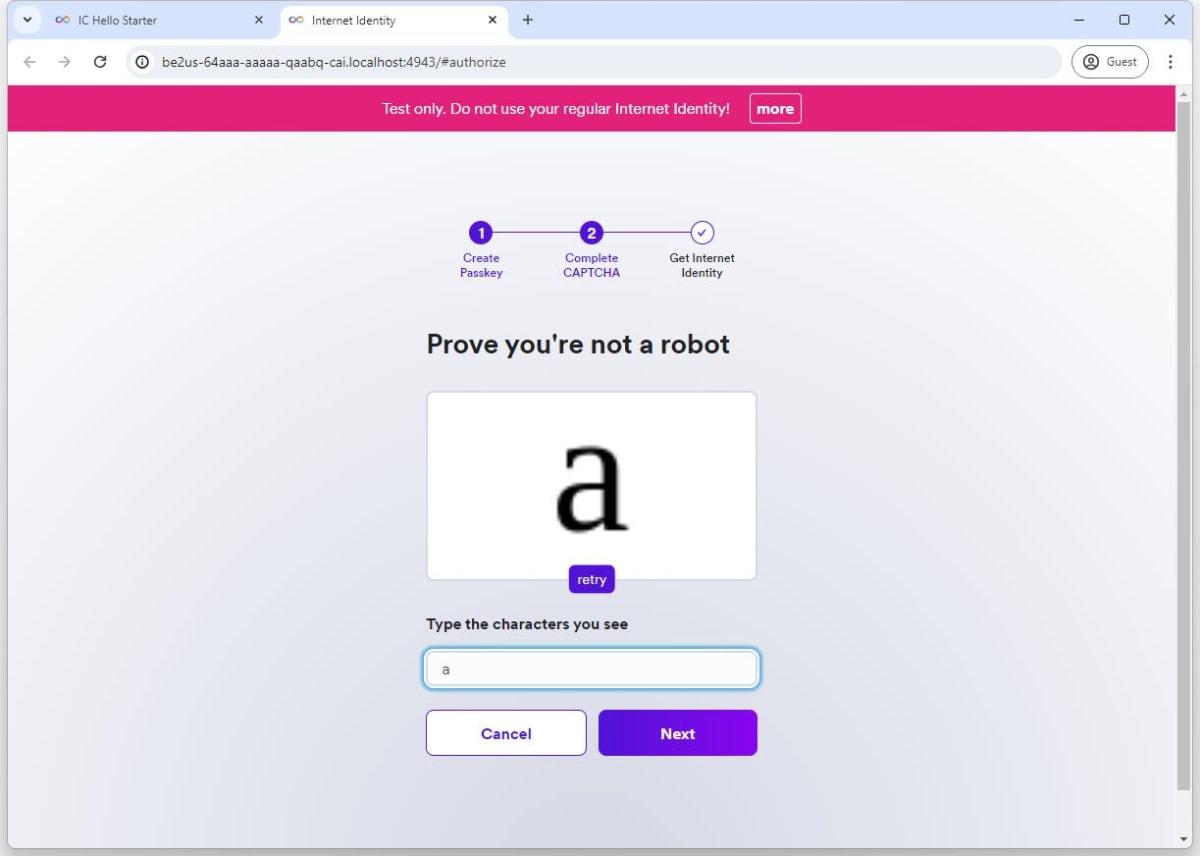
(5) テスト用のユーザー作成完了
Identity Anchorが 10000のユーザーが作成されます。
[I saved it, continue]ボタンをクリックすると認証が完了してタブがクローズします。
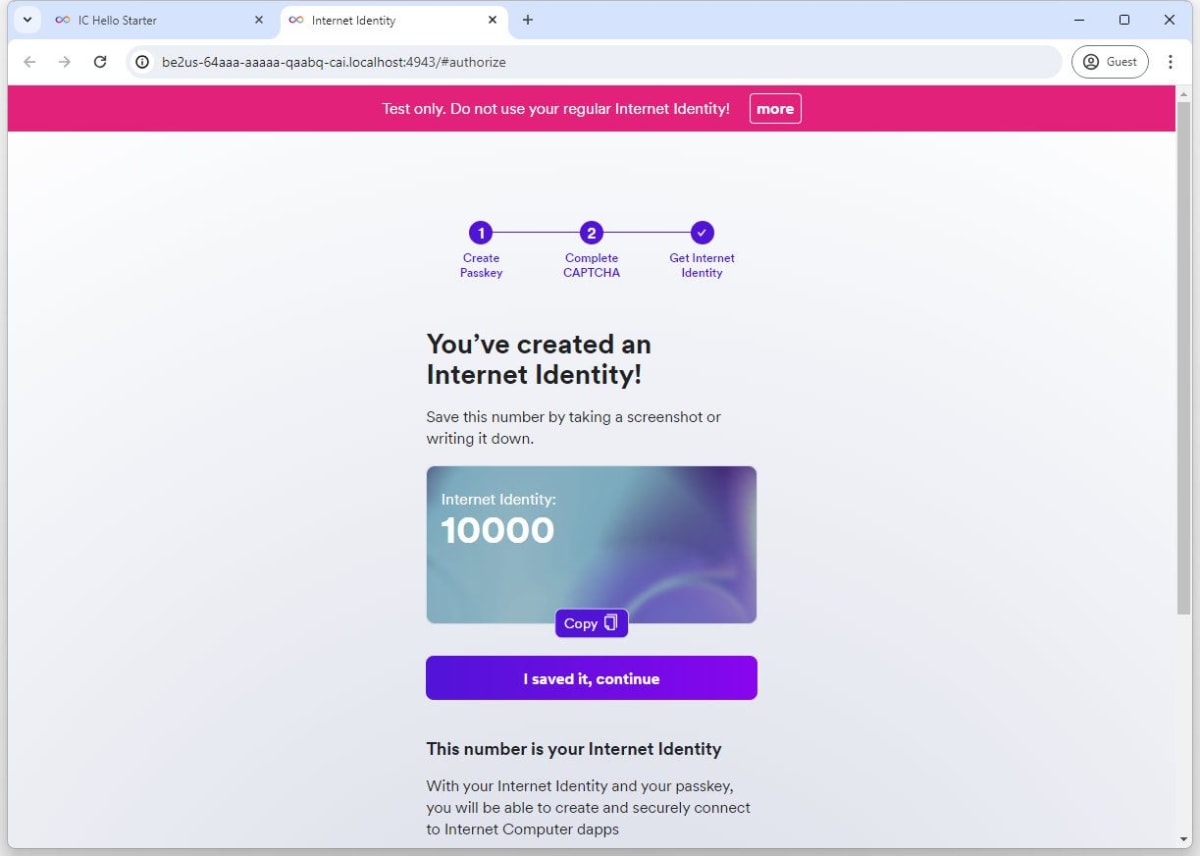
(6) ユーザー認証済画面
元のタブに戻るとユーザー認証が完了し、一意のPrincipalが割り当てられます。
『Welcome, xxxx-xxxx-…』と表示されているのがFrontend側で取得したPrincipalになります。
また、[whoami]ボタンをクリックすると、Backend Canisterが呼び出され、戻り値である呼び出し元Principalと一致していることも確認できます。

公式リファレンス
Discussion